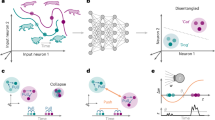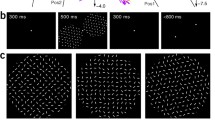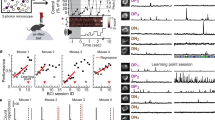Abstract
With intensive training, human can achieve impressive behavioral improvement on various perceptual tasks. This phenomenon, termed perceptual learning, has long been considered as a hallmark of the plasticity of sensory neural system. Not surprisingly, high-level vision, such as object perception, can also be improved by perceptual learning. Here we review recent psychophysical, electrophysiological, and neuroimaging studies investigating the effects of training on object selective cortex, such as monkey inferior temporal cortex and human lateral occipital area. Evidences show that learning leads to an increase in object selectivity at the single neuron level and/or the neuronal population level. These findings indicate that high-level visual cortex in humans is highly plastic and visual experience can strongly shape neural functions of these areas. At the end of the review, we discuss several important future directions in this area.
Similar content being viewed by others
References
Andrews T J, Ewbank M P (2004). Distinct representations for facial identity and changeable aspects of faces in the human temporal lobe. Neuroimage, 23(3): 905–913
Anstis S (2010). Stuart Anstis. Curr Biol, 20(18): R795–R796
Baker C I, Behrmann M, Olson C R (2002). Impact of learning on representation of parts and wholes in monkey inferotemporal cortex. Nat Neurosci, 5(11): 1210–1216
Baker C I, Liu J, Wald L L, Kwong K K, Benner T, Kanwisher N (2007). Visual word processing and experiential origins of functional selectivity in human extrastriate cortex. Proc Natl Acad Sci USA, 104(21): 9087–9092
Ball K, Sekuler R (1987). Direction-specific improvement in motion discrimination. Vision Res, 27(6): 953–965
Bao M, Yang L, Rios C, He B, Engel S A (2010). Perceptual learning increases the strength of the earliest signals in visual cortex. J Neurosci, 30(45): 15080–15084
Bentin S, Allison T, Puce A, Perez E, McCarthy G (1996). Electrophysiological studies of face perception in humans. J Cogn Neurosci, 8(6): 551–565
Bi T, Chen N, Weng Q, He D, Fang F (2010). Learning to discriminate face views. J Neurophysiol, 104(6): 3305–3311
Blakemore C, Campbell FW(1969). On the existence of neurones in the human visual system selectively sensitive to the orientation and size of retinal images. J Physiol, 203(1): 237–260
Cox D D, DiCarlo J J (2008). Does learned shape selectivity in inferior temporal cortex automatically generalize across retinal position? J Neurosci, 28(40): 10045–10055
De Baene W, Ons B, Wagemans J, Vogels R (2008). Effects of category learning on the stimulus selectivity of macaque inferior temporal neurons. Learn Mem, 15(9): 717–727
De Souza W C, Eifuku S, Tamura R, Nishijo H, Ono T (2005). Differential characteristics of face neuron responses within the anterior superior temporal sulcus of macaques. J Neurophysiol, 94(2): 1252–1266
Desimone R, Albright T D, Gross C G, Bruce C (1984). Stimulusselective properties of inferior temporal neurons in the macaque. J Neurosci, 4(8): 2051–2062
Dosher B A, Lu Z L (1998). Perceptual learning reflects external noise filtering and internal noise reduction through channel reweighting. Proc Natl Acad Sci USA, 95(23): 13988–13993
Dosher B A, Lu Z L (2005). Perceptual learning in clear displays optimizes perceptual expertise: learning the limiting process. Proc Natl Acad Sci USA, 102(14): 5286–5290
Engvig A, Fjell AM, Westlye L T, Moberget T, Sundseth O, Larsen V A, Walhovd K B (2010). Effects of memory training on cortical thickness in the elderly. Neuroimage, 52(4): 1667–1676
Fang F, Murray S O, He S (2007). Duration-dependent FMRI adaptation and distributed viewer-centered face representation in human visual cortex. Cereb Cortex, 17(6): 1402–1411
Fang F, Murray S O, Kersten D, He S (2005). Orientation-tuned FMRI adaptation in human visual cortex. J Neurophysiol, 94(6): 4188–4195
Folstein J R, Palmeri T J, Gauthier I (2012). Category learning increases discriminability of relevant object dimensions in visual cortex. Cereb Cortex, 23(4): 814–823
Freedman D J, Riesenhuber M, Poggio T, Miller E K (2006). Experience-dependent sharpening of visual shape selectivity in inferior temporal cortex. Cereb Cortex, 16(11): 1631–1644
Furmanski C S, Engel S A (2000). Perceptual learning in object recognition: object specificity and size invariance. Vision Res, 40(5): 473–484
Furmanski C S, Schluppeck D, Engel S A (2004). Learning strengthens the response of primary visual cortex to simple patterns. Curr Biol, 14(7): 573–578
Gauthier I, Skudlarski P, Gore J C, Anderson A W (2000). Expertise for cars and birds recruits brain areas involved in face recognition. Nat Neurosci, 3(2): 191–197
Gauthier I, Tarr M J (1997). Becoming a “Greeble” expert: exploring mechanisms for face recognition. Vision Res, 37(12): 1673–1682
Gilbert C D, Sigman M, Crist R E (2001). The neural basis of perceptual learning. Neuron, 31(5): 681–697
Gillebert C R, Op de Beeck H P, Panis S, Wagemans J (2009). Subordinate categorization enhances the neural selectivity in human object-selective cortex for fine shape differences. J Cogn Neurosci, 21(6): 1054–1064
Gold J, Bennett P J, Sekuler A B (1999). Signal but not noise changes with perceptual learning. Nature, 402(6758): 176–178
Goldstone R L, Lippa Y, Shiffrin R M (2001). Altering object representations through category learning. Cognition, 78(1): 27–43
Grill-Spector K, Henson R, Martin A (2006). Repetition and the brain: neural models of stimulus-specific effects. Trends Cogn Sci, 10(1): 14–23
Grill-Spector K, Kushnir T, Edelman S, Avidan G, Itzchak Y, Malach R (1999). Differential processing of objects under various viewing conditions in the human lateral occipital complex. Neuron, 24(1): 187–203
Grill-Spector K, Kushnir T, Hendler T, Malach R (2000). The dynamics of object-selective activation correlate with recognition performance in humans. Nat Neurosci, 3(8): 837–843
Grill-Spector K, Malach R (2001). fMR-adaptation: a tool for studying the functional properties of human cortical neurons. Acta Psychol (Amst), 107(1–3): 293–321
Gross C G (1992). Representation of visual stimuli in inferior temporal cortex. Philos Trans R Soc Lond Ser B-Biol Sci, 335: 3–10
Harley E M, Pope W B, Villablanca J P, Mumford J, Suh R, Mazziotta J C, Enzmann D, Engel S A (2009). Engagement of fusiform cortex and disengagement of lateral occipital cortex in the acquisition of radiological expertise. Cereb Cortex, 19(11): 2746–2754
Hubel D H, Wiesel T N (1970). The period of susceptibility to the physiological effects of unilateral eye closure in kittens. J Physiol, 206(2): 419–436
Hussain Z, Sekuler A B, Bennett P J (2008). Robust perceptual learning of faces in the absence of sleep. Vision Res, 48(28): 2785–2792
Jeffreys D A (1996). Evoked potential studies of face and object processing. Vis Cogn, 3(1): 1–38
Jiang X, Bradley E, Rini R A, Zeffiro T, Vanmeter J, Riesenhuber M (2007). Categorization training results in shape- and categoryselective human neural plasticity. Neuron, 53(6): 891–903
Kaas J H, Krubitzer L A, Chino YM, Langston A L, Polley E H, Blair N (1990). Reorganization of retinotopic cortical maps in adult mammals after lesions of the retina. Science, 248(4952): 229–231
Kahnt T, Grueschow M, Speck O, Haynes J D (2011). Perceptual learning and decision-making in human medial frontal cortex. Neuron, 70(3): 549–559
Karni A, Sagi D (1993). The time course of learning a visual skill. Nature, 365(6443): 250–252
Law C T, Gold J I (2008). Neural correlates of perceptual learning in a sensory-motor, but not a sensory, cortical area. Nat Neurosci, 11(4): 505–513
Ma L S, Wang B Q, Narayana S, Hazeltine E, Chen X Y, Robin D A, Fox P T, Xiong J H (2010). Changes in regional activity are accompanied with changes in inter-regional connectivity during 4 weeks motor learning. Brain Res, 1318: 64–76
Mollon J D, Danilova M V (1996). Three remarks on perceptual learning. Spat Vis, 10(1): 51–58
Moore C D, Cohen M X, Ranganath C (2006). Neural mechanisms of expert skills in visual working memory. J Neurosci, 26(43): 11187–11196
Mukai I, Kim D, Fukunaga M, Japee S, Marrett S, Ungerleider L G (2007). Activations in visual and attention-related areas predict and correlate with the degree of perceptual learning. J Neurosci, 27(42): 11401–11411
Op de Beeck H, Wagemans J, Vogels R (2003). The effect of category learning on the representation of shape: dimensions can be biased but not differentiated. J Exp Psychol Gen, 132(4): 491–511
Op de Beeck H P, Wagemans J, Vogels R (2007). Effects of perceptual learning in visual backward masking on the responses of macaque inferior temporal neurons. Neuroscience, 145(2): 775–789
Peissig J J, Singer J, Kawasaki K, Sheinberg D L (2007). Effects of longterm object familiarity on event-related potentials in the monkey. Cereb Cortex, 17(6): 1323–1334
Perrett D I, Smith P A J, Potter D D, Mistlin A J, Head A S, Milner A D, Jeeves M A(1985). Visual cells in the temporal cortex sensitive to face view and gaze direction. P Roy Soc B-Biol Sci, 223: 293–317
Rainer G, Lee H, Logothetis N K (2004). The effects of learning on the function of monkey extrastriate visual cortex. PLoS Biol, 2(2): 275–283
Rossion B, Gauthier I, Goffaux V, Tarr M J, Crommelinck M (2002). Expertise training with novel objects leads to left-lateralized facelike electrophysiological responses. Psychol Sci, 13(3): 250–257
Sakai K, Miyashita Y (1994). Neuronal tuning to learned complex forms in vision. Neuroreport, 5(7): 829–832
Scholz J, Klein M C, Behrens T E J, Johansen-Berg H (2009). Training induces changes in white-matter architecture. Nat Neurosci, 12(11): 1370–1371
Schoups A, Vogels R, Qian N, Orban G (2001). Practising orientation identification improves orientation coding in V1 neurons. Nature, 412(6846): 549–553
Schoups A A, Vogels R, Orban G A (1995). Human perceptual learning in identifying the oblique orientation: retinotopy, orientation specificity and monocularity. J Physiol, 483(Pt 3): 797–810
Schwartz S, Maquet P, Frith C (2002). Neural correlates of perceptual learning: a functional MRI study of visual texture discrimination. Proc Natl Acad Sci USA, 99(26): 17137–17142
Scott L S, Tanaka J W, Sheinberg D L, Curran T (2008). The role of category learning in the acquisition and retention of perceptual expertise: a behavioral and neurophysiological study. Brain Res, 1210: 204–215
Sigala N, Logothetis N K (2002). Visual categorization shapes feature selectivity in the primate temporal cortex. Nature, 415(6869): 318–320
Sigman M, Gilbert C D (2000). Learning to find a shape. Nat Neurosci, 3(3): 264–269
Sigman M, Pan H, Yang Y H, Stern E, Silbersweig D, Gilbert C D (2005). Top-down reorganization of activity in the visual pathway after learning a shape identification task. Neuron, 46(5): 823–835
Song Y Y, Hu S Y, Li X T, Li W, Liu J (2010). The role of top-down task context in learning to perceive objects. J Neurosci, 30(29): 9869–9876
Su J Z, Chen C, He D J, Fang F (2012). Effects of face view discrimination learning on N170 latency and amplitude. Vision Res, 61: 125–131
van der Linden M, Murre J M J, van Turennout M (2008). Birds of a feather flock together: experience-driven formation of visual object categories in human ventral temporal cortex. PLoS ONE, 3(12): e3995
Woloszyn L, Sheinberg D L (2012). Effects of long-term visual experience on responses of distinct classes of single units in inferior temporal cortex. Neuron, 74(1): 193–205
Wong Y K, Folstein J R, Gauthier I (2012). The nature of experience determines object representations in the visual system. J Exp Psychol Gen, 141(4): 682–698
Xiao L Q, Zhang J Y, Wang R, Klein S A, Levi D M, Yu C (2008). Complete transfer of perceptual learning across retinal locations enabled by double training. Curr Biol, 18(24): 1922–1926
Xu Y D (2005). Revisiting the role of the fusiform face area in visual expertise. Cereb Cortex, 15(8): 1234–1242
Yotsumoto Y, Watanabe T, Sasaki Y (2008). Different dynamics of performance and brain activation in the time course of perceptual learning. Neuron, 57(6): 827–833
Yu C, Klein S A, Levi D M (2004). Perceptual learning in contrast discrimination and the (minimal) role of context. J Vis, 4(3): 169–182
Zatorre R J, Fields R D, Johansen-Berg H (2012). Plasticity in gray and white: neuroimaging changes in brain structure during learning. Nat Neurosci, 15(4): 528–536
Author information
Authors and Affiliations
Corresponding author
Rights and permissions
About this article
Cite this article
Bi, T., Fang, F. Neural plasticity in high-level visual cortex underlying object perceptual learning. Front. Biol. 8, 434–443 (2013). https://doi.org/10.1007/s11515-013-1262-2
Received:
Accepted:
Published:
Issue Date:
DOI: https://doi.org/10.1007/s11515-013-1262-2




